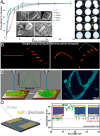Mechanoresponsive Flexible Crystals
- PMID: 38425899
- PMCID: PMC10900217
- DOI: 10.1021/jacsau.3c00481
Mechanoresponsive Flexible Crystals
Abstract
Flexible crystals have gained significant attention owing to their remarkable pliability, plasticity, and adaptability, making them highly popular in various research and application fields. The main challenges in developing flexible crystals lie in the rational design, preparation, and performance optimization of such crystals. Therefore, a comprehensive understanding of the fundamental origins of crystal flexibility is crucial for establishing evaluation criteria and design principles. This Perspective offers a retrospective analysis of the development of flexible crystals over the past two decades. It summarizes the elastic standards and possible plastic bending mechanisms tailored to diverse flexible crystals and analyzes the assessment of their theoretical basis and applicability. Meanwhile, the compatibility between crystal elasticity and plasticity has been discussed, unveiling the immense prospects of elastic/plastic crystals for applications in biomedicine, flexible electronic devices, and flexible optics. Furthermore, this Perspective presents state-of-the-art experimental avenues and analysis methods for investigating molecular interactions in molecular crystals, which is vital for the future exploration of the mechanisms of crystal flexibility.
© 2024 The Authors. Published by American Chemical Society.
Conflict of interest statement
The authors declare no competing financial interest.
Figures














References
-
- Zheng Y.; Jia X.; Li K.; Xu J.; Bu X. H. Energy Conversion in Single-Crystal-to-Single-Crystal Phase Transition Materials. Adv. Energy Mater. 2022, 12 (4), 2100324.10.1002/aenm.202100324. - DOI
Publication types
LinkOut - more resources
Full Text Sources
Miscellaneous
